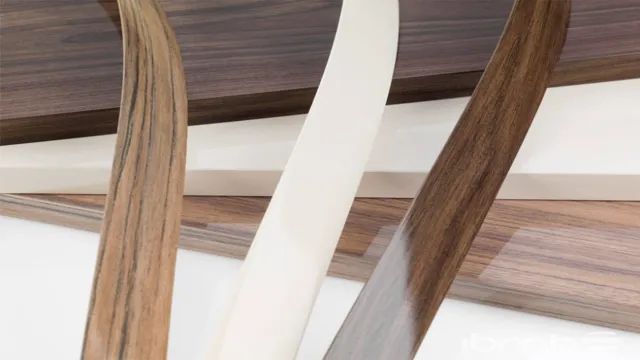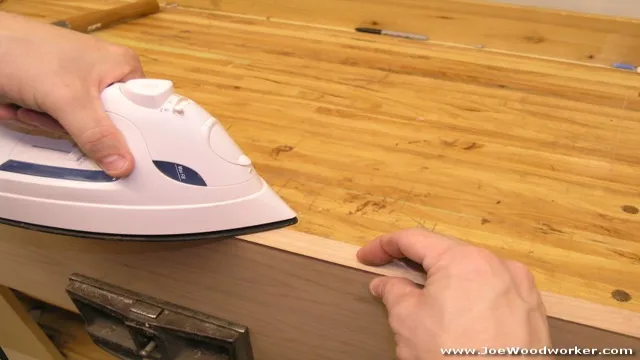When it comes to adding edge banding to your woodworking project, there are a lot of considerations to keep in mind. One of the most common questions is whether or not you can stain edge banding. The answer is: it depends.
Edge banding is typically made from either PVC or wood veneer. PVC edge banding is a plastic material that is often used for cabinetry and furniture. Wood veneer edge banding, on the other hand, is made from real wood and is usually used for high-end furniture and cabinetry.
The process of staining edge banding depends on the type of material you are working with. PVC edge banding cannot be stained because it is a plastic material. However, wood veneer edge banding can be stained just like any other type of real wood.
It’s important to note that the process of staining edge banding is different from staining solid wood. Edge banding is a thin strip of material that is applied to the edge of a piece of wood to give it a finished look. This means that the staining process needs to be carefully done to avoid getting any stain on the surrounding wood.
If you’re working with wood veneer edge banding and want to stain it, it’s important to make sure that the edge banding is properly sanded and prepped before applying any stain. This will ensure that the stain adheres properly and gives you the desired finish. In summary, while you can’t stain PVC edge banding, you can definitely stain wood veneer edge banding.
Just make sure to properly prep the edge banding and be careful during the staining process to avoid getting any stain on the surrounding wood.
What is Edge Banding?
Edge banding is the process of adding a thin strip of material to the edges of a sheet or panel to conceal any exposed or rough edges. The material used to edge band can vary, including PVC, wood veneer, and metal. While the banding can be stained to match the color of the surface it is applied to, not all types of edge banding will work well with staining.
For example, PVC edge banding typically cannot be stained, as the plastic material will not absorb the stain like wood veneer or metal would. It’s important to research and choose the appropriate edge banding material for your project based on your desired finish. If you’re unsure whether your edge banding can be stained, it’s always best to test a small area first before proceeding with the full application.
Definition and Use
Edge Banding is a process used to cover the exposed sides of composite wood or plywood with a band of thin material. This banding is typically made of thin strips of wood, PVC, or acrylic that are adhered to the raw edge of the board to provide a finished look. The process typically involves using specialized equipment like an edge banding machine to apply the banding to the edge.
The edge banding is commonly used in the furniture industry to add a professional look to the design of cabinets, tables, and shelving units. It is also popular in the interior design industry for use in creating custom furniture and decorative elements. By applying edge banding, the sharp edges of the composite materials are concealed, allowing a seamless and aesthetically pleasing finish.

Materials Used in Edge Banding
Edge banding is a process that involves placing a thin material (usually a strip of wood, PVC, or acrylic) on the exposed edges of a board to cover and protect them. This helps provide a finished and polished look to furniture and other projects. It is a great way to cover up the unfinished edges of particleboard, MDF, and plywood materials.
There are several materials used in edge banding, including melamine, wood veneers, PVC, acrylic, and metal. Each material has its unique advantages, such as durability, flexibility, and cost-effectiveness. Melamine is known for its excellent scratch and heat resistance, while wood veneers provide an attractive and natural appearance.
PVC and acrylic edge banding come in various colors and textures, making them ideal for modern furniture designs. Metal edge banding is perfect for high-end applications, especially on commercial and industrial projects. Overall, edge banding provides a budget-friendly and aesthetic appeal to furniture and construction works.
Staining Edge Banding
If you’re wondering whether you can stain edge banding, the answer is a resounding yes! Edge banding is a strip of material used to cover the exposed sides of plywood, particleboard, or MDF. It’s usually made from wood veneer or PVC, and it’s available in a wide range of colors, patterns, and finishes. To stain edge banding, you’ll need to follow a few simple steps.
First, you’ll need to sand the edge banding to remove any rough spots or imperfections. Then, you’ll need to apply a coat of wood conditioner to help the stain penetrate evenly. Once the conditioner has dried, you can apply your chosen stain color, using a brush or cloth to wipe away any excess.
Finally, you’ll need to seal the edge banding with a clear coat of finish to protect it from damage. With the right tools and techniques, staining edge banding is a straightforward process that can help you achieve a professional and polished look for your woodworking projects.
Types of Stains for Edge Banding
When it comes to edge banding, staining the material can give it a more polished, finished look. There are several types of stains that can be used on edge banding, each with their own unique qualities. One popular type is oil-based stains, which penetrate the material deeply and provide a rich, vibrant color.
Another option is water-based stains, which are more environmentally friendly and dry quickly. Gel stains are also available, which provide a thicker, more consistent coating. Regardless of which type you choose, it’s important to properly prepare the edge banding surface before applying the stain and to apply it evenly for the best results.
So next time you’re looking to enhance the appearance of your edge banding, consider staining it to give it a professional finish.
Preparation and Application Process
Staining edge banding is a crucial step in achieving a flawless finish for your woodworking project. Before starting, you should ensure that the edge banding is cleaned and sanded to a smooth finish, free from any dust or debris. Once the preparation is done, it’s time to apply the stain.
To start, make sure the stain is mixed well and tested on a small piece of edge banding to ensure that it is the desired color. Using a clean cloth, apply the stain in a smooth, even motion following the direction of the grain. Remember to apply the stain lightly and not overbrush, as this can lead to blotches and uneven coloring.
Once the first coat is dry, apply a second coat, repeating the process until you reach the desired color. Remember to give ample time for the stain to dry before handling the edge banding. By using this process, you can achieve a beautiful and uniform finish that will last for years to come.
Tips for Achieving a Uniform Finish
When staining edge banding, it is important to follow a few tips to achieve a uniform finish. First, it is essential to prepare the surface and remove any dust or debris. Next, apply a sanding sealer to ensure the stain is applied evenly.
When applying the stain, use a brush or cloth in the direction of the grain to avoid any blotches or streaks. The key to achieving a consistent color is to apply a thin coat and allow it to dry completely before adding another layer. Avoid over-applying the stain as it can result in a darker and uneven finish.
Using a high-quality stain and sealer can also help ensure a uniform appearance. By following these simple steps, you can achieve a professional and attractive finished look for your edge banding project.
Conclusion
In conclusion, the answer to the question ‘Can you stain edge banding?’ is a categorical ‘yes’. However, it’s important to ensure that the edge banding material is compatible with the type of stain you are using, and that you apply the stain evenly and carefully to achieve the desired finish. So don’t be afraid to experiment with staining your edge banding to add some extra character and charm to your woodworking projects – the possibilities are endless!”
Summary of the Process
Staining edge banding is an integral part of the process when it comes to woodworking. It is the technique of applying color or stain to the edges of veneered panels or MDF edges. The process not only solidifies the edge of the panel but also makes it more visually appealing.
First, the edge banding is prepared by sanding and cleaning it thoroughly to ensure that it is free from any debris. Then, the stain is applied to the edge banding using a foam brush or a lint-free cloth, ensuring that the stain is evenly distributed. The amount of stain applied may vary depending on the desired shade, but it is important to ensure that the edge banding is properly covered.
Once the stain is dry, a lacquer or topcoat can be applied to the edge banding to enhance its durability and give it a glossy finish. Staining edge banding requires attention to detail and precision as the final result will depend on how well the stain is applied. Overall, staining edge banding is an easy technique that can be done by anyone with basic woodworking skills.
Benefits and Considerations for Staining Edge Banding
Staining edge banding is a process that involves applying a wood stain to the edge of a piece of wood. This technique is commonly used in the furniture industry, as it provides an aesthetic and uniform finish to the edges of furniture pieces. There are several benefits of staining edge banding, including the fact that it enhances the natural beauty of the wood, hides any imperfections on the edges, and provides protection against moisture and wear and tear.
When considering whether to stain edge banding, it is important to first select a wood stain that complements the type of wood you are working with. Additionally, it is crucial to ensure that the edges are sanded and prepared properly before the staining process begins. Overall, staining edge banding is a great way to enhance the look of your furniture pieces and protect them from the wear and tear of daily use.
FAQs
What is edge banding made of?
Edge banding is usually made from plastic, wood, or metal materials.
How is edge banding applied?
Edge banding is usually applied using heat or adhesive glue.
What colors does edge banding come in?
Edge banding can come in a variety of colors, from natural wood tones to bright primary colors.
Can edge banding be stained to match the surrounding wood?
Yes, it is possible to stain edge banding to match the surrounding wood, although it may require some experimentation to get the color just right.
What is the difference between pre-glued and unglued edge banding?
Pre-glued edge banding comes with a layer of adhesive already applied to the back, while unglued edge banding requires a separate adhesive to be applied before installation.
How thick is edge banding typically?
Edge banding is usually between 0.5mm and 2mm thick, depending on the material used.
Can edge banding be removed if it needs to be replaced?
Yes, edge banding can be removed with a heat gun or other specialized tools if it needs to be replaced or repaired.






